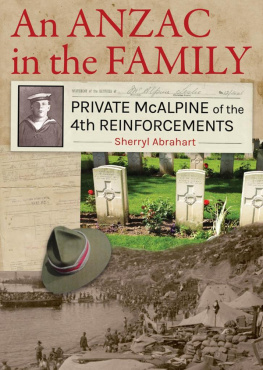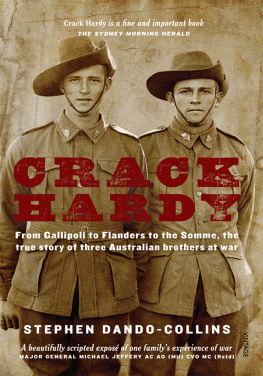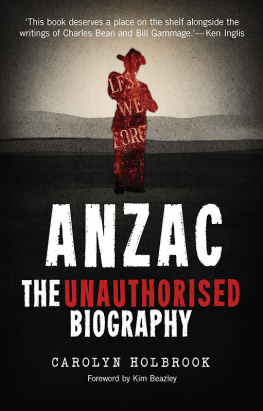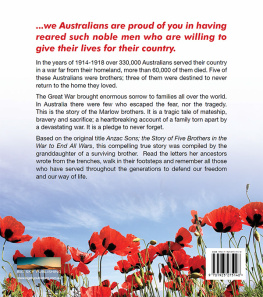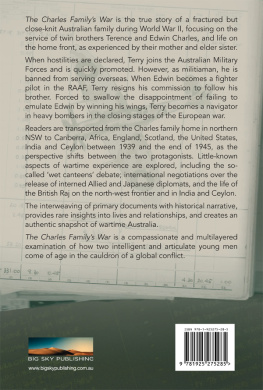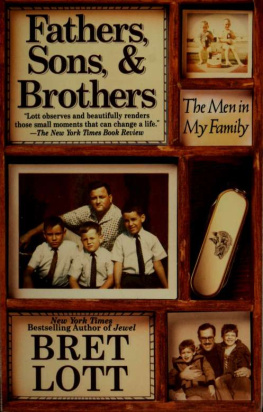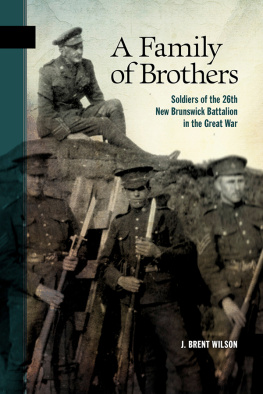ANZAC
THE STORY OF FIVE BROTHERS IN THE WAR TO END ALL WARS
SONS
ANZAC
THE STORY OF FIVE BROTHERS IN THE WAR TO END ALL WARS
SONS

Allison Marlow Paterson
Copyright Allison Marlow Paterson
First published 2014
Copyright remains the property of the authors and apart from any fair dealing for the purposes of private study, research, criticism or review, as permitted under the Copyright Act, no part may be reproduced by any process without written permission.
All inquiries should be made to the publishers.
Big Sky Publishing Pty Ltd
PO Box 303, Newport, NSW 2106, Australia
Phone: 1300 364 611
Fax: (61 2) 9918 2396
Email:
Web: www.bigskypublishing.com.au
Cover design and typesetting: Think Productions
Printed in China by Asia Pacific Offset Ltd
National Library of Australia Cataloguing-in-Publication entry (pbk.)
Author: | Paterson, Allison Marlow |
Title: | Anzac sons : the story of five brothers in the war to end all wars / Allison Marlow Paterson. |
ISBN: | 9781922132796 (paperback)
9781922132802 (ebook) |
Subjects: | World War, 1914-1918--Personal narratives.
Soldiers--Australia--Correspondence.
World War, 1914-1918--Campaigns--Western Front. |
Dewey Number: 940.30922
Printed in China through Asia Pacific Offset Ltd
CONTENTS
PREFACE
Anzac Sons is an account of the Great War experiences of five brothers drawn from a collection of over 500 letters written to their families at home. The letters, penned by my grandfather and four of his brothers, were sent from the training grounds of Victoria, from Egypt, England and the battlefields of the Western Front Pozieres, Bullecourt, Messines, Menin Road, Passchendaele, Villers-Bretonneux and the village battlegrounds of 1918. The narrative that runs through these letters not only provides an insight into the experiences and suffering of a family, but also into the tragic deaths of their friends and the impact of such events on the small Australian community they called home. The letters also reveal much about the young men themselves their motivation for enlisting, their fears and their grief. The story of their family and the way its members coped with the tragedy that ultimately consumed their lives forms a strong undercurrent to this narrative and reflects the experiences of families the length and breadth of the nation.
In their original form, some of the letters are crumbling, torn and stained. Most are written in pencil, now faded with the impact of time. The transcriptions in this book are as accurate as possible and each letter is presented as it was written. Occasionally the sentiments expressed have not stood the test of time and may even be offensive to some readers. If this is the case I apologise. These letters should be read in the context in which they were written as personal letters addressed to loved ones almost 100 years ago in what was a different age, entirely removed from the sensitivities of the modern age. I have preserved all emphases from the original letters, including any underlining, as these illustrate the emotions at the heart of these words. Occasionally I have included an interpretation and these interjections will be indicated as such, employing the usual practice of enclosing them in square brackets [interjection].
I am responsible for any errors of fact in this volume. My thoughts and reflections on what happened to my ancestors have been refined and developed by my research, by careful reading of their letters, discussion with family members, my own recollections and memories and the experience of days spent traversing the battlefields of the Western Front. On many occasions I express an opinion which I only wish could be clarified by those involved.
A FEW TECHNICALITIES:
Allan Marlow enlisted with his Christian name spelt Allan. Inexplicably he later changed the spelling to Allen. To avoid confusion I have chosen the earlier spelling of Allan.
In my narrative I have adopted the metric system of measurement rather than the imperial. The letters contain imperial measurements as used at the time:
1 mile = 1.6 kilometres
1 yard = 0.91 metres
1 chain = 20.1 metres
The Australian currency system was based on the old British system of 12 pence to a shilling and 20 shillings to a pound:
1 pence (penny) written as 1d
12 pence = 1 shilling (or a bob) written as 1s or 1/
20 shillings = 1 pound written as 1
Australian soldiers were paid six shillings a day, more than the average worker, and were the highest paid regular soldiers in World War I. Early in the war the Australian recruits were often referred to as six bob a day tourists by critics who believed that the Australians would not see any action. The soldiers later adopted this term for their own use in a piece of bitter irony. Nonetheless, many troops made the most of their opportunities to see the sights of North Africa and Europe. If a soldier had dependants he was required to allocate at least two shillings to his family. One shilling was deferred for payment on discharge.
When Australia adopted the decimal currency in 1966, one pound was exchanged for two dollars, with one shilling valued at ten cents. As a comparative guide to values, to post a letter or buy a loaf of bread cost approximately 1d in 1916. In a letter dated July 1917, Charlie complains that a peach in France costs 10d, almost the value of six loaves of bread and the approximate cost of a dozen eggs in Australia at the time.
AUSTRALIAN MILITARY STRUCTURE
In 1916, I Anzac Corps consisted of the 1st, 2nd and NZ divisions under British General William Birdwood, who also commanded all Australian forces. II Anzac Corps comprised the recently formed 4th and 5th divisions under British Lieutenant General Alexander Godley. In July 1916, when II Anzac arrived on the Western Front, followed later by the 3rd Division, the formation was reorganised. I Anzac Corps then comprised the 1st, 2nd and 4th divisions and II Anzac the 3rd, 5th and New Zealand divisions. Generally, each division was commanded by a major general and comprised three infantry brigades, three artillery brigades, a headquarters and field engineers. A brigade, commanded by a brigadier or brigadier general, was then divided into battalions of between 800 and 1000 men. A battalion, under the command of a lieutenant colonel or colonel, was divided into four companies. Each company was commanded by a captain and comprised four infantry platoons. A platoon was commanded by a lieutenant and divided into four sections commanded by a corporal.
ACKNOWLEDGEMENTS
We owe an enormous debt of gratitude to the men and women who sacrificed so much in the Great War. Not only are we indebted to those who served, but also to their families who suffered the traumatic loss of loved ones both on the battlefield and in the permanent scars of those who returned. Their experiences were horrific and heartbreaking.
My sincere thanks to all who researched and wrote on the history of World War I, and whose work is essential to any understanding of this immense conflict: Charles Bean, Eric Fairey, Bill Gammage, Lyn McDonald, Patsy Adam-Smith, Peter Stanley, Les Carlyon, Peter Pedersen and all those listed in the recommended reading list at the end of this volume. I acknowledge the important work of the Pyramid Hill and District Historical Society and their excellent publications associated with the Pyramid Hill Advertiser
Next page


